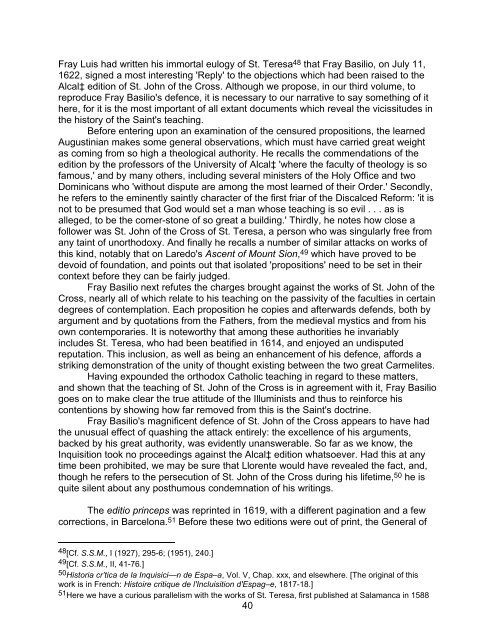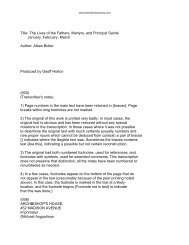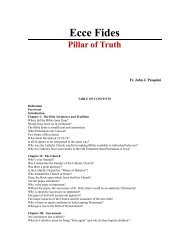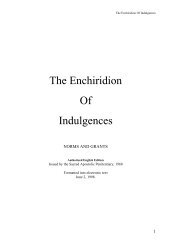Ascent of Mt. Carmel - St. Patrick's Basilica
Ascent of Mt. Carmel - St. Patrick's Basilica
Ascent of Mt. Carmel - St. Patrick's Basilica
You also want an ePaper? Increase the reach of your titles
YUMPU automatically turns print PDFs into web optimized ePapers that Google loves.
Fray Luis had written his immortal eulogy <strong>of</strong> <strong>St</strong>. Teresa 48 that Fray Basilio, on July 11,<br />
1622, signed a most interesting 'Reply' to the objections which had been raised to the<br />
Alcal‡ edition <strong>of</strong> <strong>St</strong>. John <strong>of</strong> the Cross. Although we propose, in our third volume, to<br />
reproduce Fray Basilio's defence, it is necessary to our narrative to say something <strong>of</strong> it<br />
here, for it is the most important <strong>of</strong> all extant documents which reveal the vicissitudes in<br />
the history <strong>of</strong> the Saint's teaching.<br />
Before entering upon an examination <strong>of</strong> the censured propositions, the learned<br />
Augustinian makes some general observations, which must have carried great weight<br />
as coming from so high a theological authority. He recalls the commendations <strong>of</strong> the<br />
edition by the pr<strong>of</strong>essors <strong>of</strong> the University <strong>of</strong> Alcal‡ 'where the faculty <strong>of</strong> theology is so<br />
famous,' and by many others, including several ministers <strong>of</strong> the Holy Office and two<br />
Dominicans who 'without dispute are among the most learned <strong>of</strong> their Order.' Secondly,<br />
he refers to the eminently saintly character <strong>of</strong> the first friar <strong>of</strong> the Discalced Reform: 'it is<br />
not to be presumed that God would set a man whose teaching is so evil . . . as is<br />
alleged, to be the comer-stone <strong>of</strong> so great a building.' Thirdly, he notes how close a<br />
follower was <strong>St</strong>. John <strong>of</strong> the Cross <strong>of</strong> <strong>St</strong>. Teresa, a person who was singularly free from<br />
any taint <strong>of</strong> unorthodoxy. And finally he recalls a number <strong>of</strong> similar attacks on works <strong>of</strong><br />
this kind, notably that on Laredo's <strong>Ascent</strong> <strong>of</strong> Mount Sion, 49 which have proved to be<br />
devoid <strong>of</strong> foundation, and points out that isolated 'propositions' need to be set in their<br />
context before they can be fairly judged.<br />
Fray Basilio next refutes the charges brought against the works <strong>of</strong> <strong>St</strong>. John <strong>of</strong> the<br />
Cross, nearly all <strong>of</strong> which relate to his teaching on the passivity <strong>of</strong> the faculties in certain<br />
degrees <strong>of</strong> contemplation. Each proposition he copies and afterwards defends, both by<br />
argument and by quotations from the Fathers, from the medieval mystics and from his<br />
own contemporaries. It is noteworthy that among these authorities he invariably<br />
includes <strong>St</strong>. Teresa, who had been beatified in 1614, and enjoyed an undisputed<br />
reputation. This inclusion, as well as being an enhancement <strong>of</strong> his defence, affords a<br />
striking demonstration <strong>of</strong> the unity <strong>of</strong> thought existing between the two great <strong>Carmel</strong>ites.<br />
Having expounded the orthodox Catholic teaching in regard to these matters,<br />
and shown that the teaching <strong>of</strong> <strong>St</strong>. John <strong>of</strong> the Cross is in agreement with it, Fray Basilio<br />
goes on to make clear the true attitude <strong>of</strong> the Illuminists and thus to reinforce his<br />
contentions by showing how far removed from this is the Saint's doctrine.<br />
Fray Basilio's magnificent defence <strong>of</strong> <strong>St</strong>. John <strong>of</strong> the Cross appears to have had<br />
the unusual effect <strong>of</strong> quashing the attack entirely: the excellence <strong>of</strong> his arguments,<br />
backed by his great authority, was evidently unanswerable. So far as we know, the<br />
Inquisition took no proceedings against the Alcal‡ edition whatsoever. Had this at any<br />
time been prohibited, we may be sure that Llorente would have revealed the fact, and,<br />
though he refers to the persecution <strong>of</strong> <strong>St</strong>. John <strong>of</strong> the Cross during his lifetime, 50 he is<br />
quite silent about any posthumous condemnation <strong>of</strong> his writings.<br />
The editio princeps was reprinted in 1619, with a different pagination and a few<br />
corrections, in Barcelona. 51 Before these two editions were out <strong>of</strong> print, the General <strong>of</strong><br />
48 [Cf. S.S.M., I (1927), 295-6; (1951), 240.]<br />
49 [Cf. S.S.M., II, 41-76.]<br />
50Historia cr’tica de la Inquisici—n de Espa–a, Vol. V, Chap. xxx, and elsewhere. [The original <strong>of</strong> this<br />
work is in French: Histoire critique de l'Incluisition d'Espag–e, 1817-18.]<br />
51Here we have a curious parallelism with the works <strong>of</strong> <strong>St</strong>. Teresa, first published at Salamanca in 1588<br />
40






